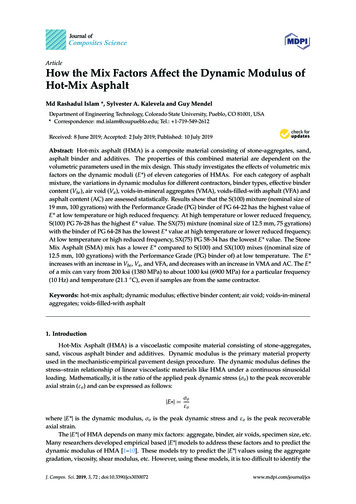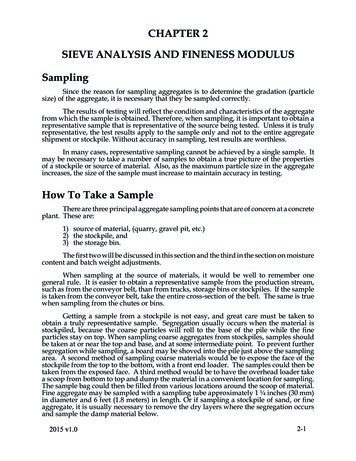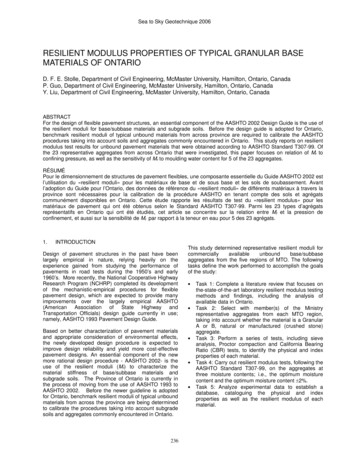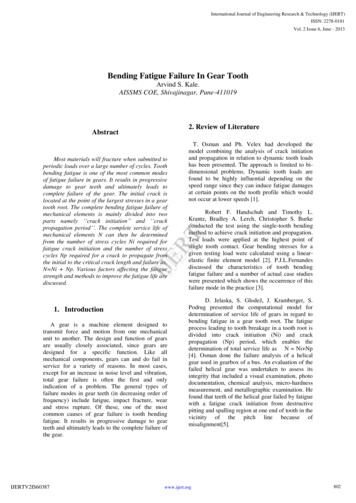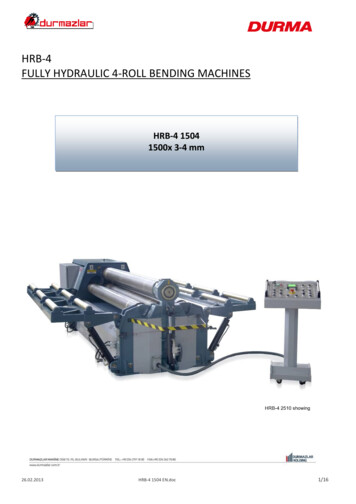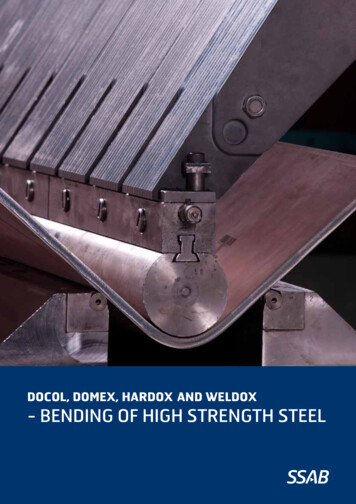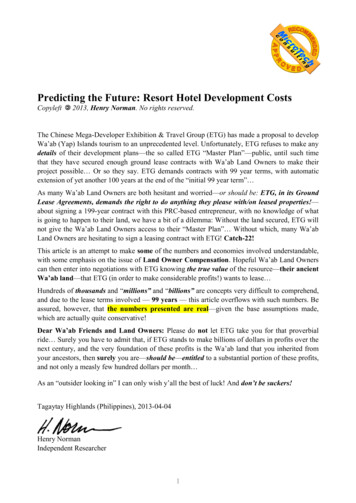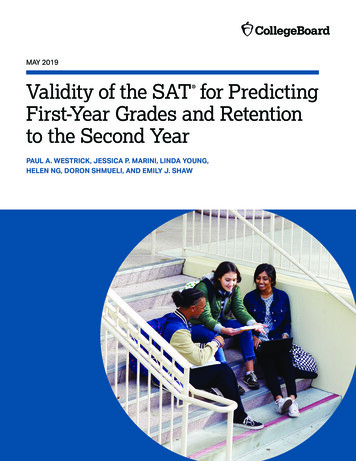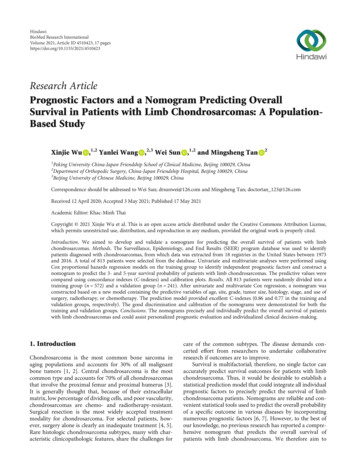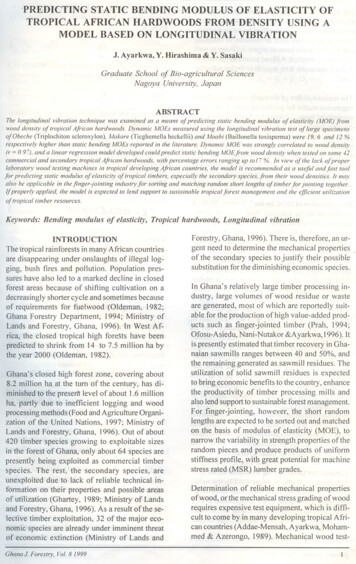
Transcription
'PREDICTING STATIC BENDING MODULUS OF ELASTICITY OFTROPICAL AFRICAN HARDWOODS FROM DENSITY USING AMODEL BASED ON LONGITUDINAL VIBRATIONJ. Ayarkwa, Y. Hirashima & Y. SasakiGraduate School of Bio-agricultural SciencesNagoya University, JapanABSTRACTThe longitudinal vibration technique was examined as a means of predicting static bending modulus of elasticity (/vIOE)ji-omwood density of tropical African hardwoods. Dynamic /vIOEs measured using the longitudinal vibration test of large specimensofObeche (Triplochiton scleroxylon), /vIakore (Ticghemella heckellii) and /vIoabi (Baillonella toxisperma) were 19,6 and 12 %respectively higher than static bending /vIOEs reported in the literature. Dynamic /vIOE was strongly correlated to wood density(r n.97), and a linear regression model developed could predict static bending /vIOEji-om wood density when tested on some 42commercial and secondary tropical Afl"ican hardwoods, with percentage errors ranging up to 17 %. /n view o/the lack 0/ properlaboratory wood testing machines in tropical developing Afl"ican countries, the model is recommended as a useful and fast toolfor predicting static modulus 0/ elasticity of tropical timbers, especially the secondOlY species, ji-om their wood densities. It mayalso be applicable in the ]inger-jointing industry for sorting and matching random short lengths of timber for jointing together.lfproperlyapplied,the model is expected to lend support to sustainable tropical forest management and the efficient utilizationof tropical timber resources.Keywords: Bending modulus of elastici(v, Tropical hardwoods, Longitudinal vibrationINTRODUCTIONForestry, Ghana, 1996). There is, therefore, an ur-The tropical rainforests in many African countriesare disappearing under onslaughts of illegal logging, bush fires and pollution. Population pressures have also led to a marked decline in closedgent need to determine the mechanical properties,of the secondary species to justify their possiblesubstitution for the diminishing economic species.forest areas because of shifting cultivation on adecreasingly shorter cycle and sometimes becauseof requirements for fuelwood (Oldeman, 1982;Ghana Forestry Department, 1994; Ministry ofLands and Forestry, Ghana, 1996). In West Africa, the closed tropical high fore ts have beenpredicted to shrink from 14 to 7.5 million ha bythe year 2000 (Oldeman, 1982).In Ghana's relatively large timber processing industry, large volumes' of wood residue or wasteare generated, most of which are reportedly suitable for the production of high value-added products such as finger-jointed timber (Prah, 1994;Ofosu-Asiedu, Nani-Nutakor &Ayarkwa, 1996). Itis presently estimated that timber recovery in Ghanaian sawmills ranges b tween 40 and 50%, andthe remaining generated as sawmill residues. Theutilization of solid sawmill residues is expectedto bring economic benefits to the country, enhancethe productivity of timber processing mills andalso lend support to sustainable forest management.For finger-jointing,however, the short randomlengths are expected to be sorted out and matchedon the basis of modulus of elasticity (MOE), tonarrow the variability in strength properties of therandom pieces and produce products of uniformstiffness profile, with great potential for machinestress rated (MSR) lumber grades.Ghana's closed high forest zone, covering about8.2 million ha.at the turn of the century, has diminished to the presen't level of about 1.6 millionha, partly due to inefficient logging and woodprocessing methods (Food and Agriculture Organization of the United Nations, 1997; Ministry ofLands and Forestry, Ghana, 1996). Out of about420 timber species growing to exploitable sizesin the forest of Ghana, only about 64 species arepresently being exploited as commercial timberspecies. The rest, the secondary species, areunexploited due to lack of reliable technical information on their properties and possible areasof utilization (Ghartey, 1989; Ministry of Landsand Forestry, Ghana, 1996). As a result of the selective timber exploitation, 32 of the major economic species are already under imminent threatof economic extinction (Ministry of Lands andGhana 1. Forestry, Vo/. 8 1999Determination of reliable mechanical propertiesof wood, orthe mechanical stress grading of woodrequires expensive test equipment. which is difficult to come by in many developing tropical African countries (Addae-Mensah, Ayarkwa, Mohammed & Azerongo, 1989). Mechanical wood test-
PredictingMOE of tropical African hardwoodsJ. Ayarkwafrom densitying machines available are old-fashionedandtherefore unreliable. The need to obtain a fast,reliable and easy-to-use method for estimating mechanical properties such as modulus of elasticity(MOE), has never been so urgent in Ghana as wellas in many tropical African countries to help inmaking decisions with regards to timber substitution.The main objective of the study was to develop aregression model for predicting static modulus ofelasticity oftropical African hardwoods from wooddensity. Since density is one of the easiest woodproperties to determine, such a model was expected to give fast and reliable first-hand information on the mechanical properties of the secondary timber species. The model was also to beused for sorting out and matching random timberpieces from sawmill residue for finger-jointing.The general equation relating wavelength (A.) tolength of the rod (L) and mode of vibration (n) isgiven by,A. 2LThe wavelengthto the frequencyis the ratio of wave velocity (C)of vibration (f),Thus, A.Combining the three equations gives an expression for the frequency of vibration as follows:f n.JE/pRearranging equation 4 and introducing weightper unit volume and gravitational acceleration, inorder to obtain MOE with units of force per unitarea, gives for the fundamental frequency (n I),termining the elastic properties of wood, dynamicmethods such as the vibration test based on meas-(A g)ity, C, of propagation of sinusoidal wave in 1helongitudinal direction of a rod supported at midpoint, is determined by the ratio of the modulusof elasticity, E, to the mass density, r, as follows:c .J(E/p)GhmiaJ. Forllslry,1'0181999.1.42LE (4W LFormula for Detarmining Dynamic MOEAccording to Bodig & Jayne (1982), the veloc-3fIn addition to the standard static methods of de-10% higher than by static tests for Spruce andBeech. The dynamic method of determining MOEhas the advantage of comparatively shorter testduration (Kollman & Cote, 1968).2nDetermination ofMOE by the Vibration Methodurement of natural frequency, has been used formany years (Hearmon, 1965; Kollman & Cote,1968; Bodig & Jayne, 1982; Tsoumis, 1991;Bucur, 1995). The accuracy of the determinationof MOE of wood by the vibration tests is higherthan that of static tests (Kollman & Cote, 1968;Bodig & Jayne, 1982; Tsoumis, 1991). The difference is due to the rate of loading and otherphenomenon (Bodig & Jayne, 1982). Kollman &Krech (1960) obtained from vibration test ofSpruce and Oak, 19 and 14% increases respectively over static test values, and these differencesare small and negligible (Kollman & Cote, 1968).According to Bodig & Jayne (1982), MOE 01Ttained by vibration tests proves to be 5 to 15%higher than that by static tests. Tsoum is (1991)also reports that the difference ranges frem 10 to15%. Bucur (1995) also reports that Young'smodulus determined from resonance tests is aboutet al.r )9.8 xlO·5.5whereE modulus of elasticity, MOE (GPa)W weight of timber (kgf)L length of timber (cm)f fundamental resonant frequency (S·I)A cross-sectional area of timber sample(cm2)g gravitationalacceleration(cm/s2)Thus, the dynamic modulus of elasticity of a timber piece can be determinedfrom its length,weight, cross-sectional area, fundamental resonantfrequency and the gravitational acceleration.MA TERIALS AND METHODSPreparation of SpecimensWood samples of the following three tropicalhardwoods of/ow, medium and high densities respe tively were used for the study:Obeche (Triplochitol1 scleroxylol1)Makore (Tieghemella heckellii Pierre)Moabi (Bail/onella toxi5perma Pierre)Radial-sawn, straight-grained heartwood samples(Fig. 1) were randomly collected from three logsof each species. The samples were planed and crosscut to final dimensions (Table I) such that no visible defects such as knots and spiral grains wereprisent, and growth layers were at right angle tothe width of each specimen. The kiln-dried samples were conditioned to about 8% moisture con2
PredictingMOE of tropical African hardwoodstent for the test. In all 638 specimensTAIlLEwere tested.IOuantities and dimensions o{limber lest specimenslimber speciesJ. Ayarkwafrom densityet al.density of each wood species and for the combined data of the three species. The models usedin the regression analyses were of the followingform:Tesl specimensDimensionsQ:,,:ntilYf.JJJ.!!.JlObeche (/i-ip/ochilon scleroxylon) 23x 155:\ 1000Makore (Tiegheme//a heckellii)23x 155x I 00023xl30xl000Moabi (Bai//onella loxisperma)2] 0218210Tala I638Testing MethodsWood DensityWood density was determined in accordance withASTM 02395-93. The mass of each specimen wasdetermined using an electronic weighing balance,and the volume determined from the exact dimensions of each specimen measured at three locations along the specimen and averaged to ensureaccuracy. The density was calculated as the ratioof mass to volume of each specimen. Po PI 01 c:E2 Po P: O2 2EJ Po : OJ JFor Obeche,For Makore,For Moabi,E:For the three species, Ewhere o p CE:, E: ' EJ and E dynamic MOE of Obeche,Makore, Moabi and any tropical A frican hardwood respectively0:, O2, OJ and 0 wood density of Obeche,Makore, Moabi and any tropical African hardwood respectively o' Pic1' 2'cJ regression coefficients residual errorsand Dynamic Modulus of Elasticity (MOE)The dynamic modulus of elasticity was determinedby the longitudinal vibration test. The techniCJueinvolved introducing vibration into the test specimen by mechanical impact using a hammer, andthe vibration received by a microphone, whichtransmitted the sound waves into a Frequency(FFT) Analyzer (Fig. 2). Peak frequency of "i!d Izwas selected. The fundamentalresonance frequency was then measured by the FFT Analyzer,to an accuracy of 1Hz, and recorded. The mod);lIus of elasticity of the specimen was then calculated using Formula 5. For comparison with datain the literature. the test data were corrected to12% moisture content before the analyses, in accordance with ASTM 02915-94 as follows:Cutting of flitchesSawing of boardsSample boardFig. 1 Samples cutting patternTest specimenwhereHammerP: MOE measured at moisture content M1P: MOE adjusted to moisture content M:M: M: moisture contents (%)a, P moisture content constants, 1.44 and0.02 respectivelyModel DevelopmentThe mechanical properties of clear wood are generally linearly related to wood density (Kollman& Cote, 1968; Forest Products Laboratory, 1987;Bodig & Jayne, 1982; Sucur, 1995). Least squaresregression analyses were therefore performed tocorrelate dynamic modulus of elasticity to theGhanaJ. Forestry, Vol. 8 1999Fig. 2. SchematicJiagralll oflongitliJinalvibrationte,[ 'L'lll!,RESULTS AND DISCUSSIONTable 2 presents a summary of test results showing the mean values, coefficients of variation andmaximum and minimum values for dynamic modulus of elasticity (MOE) and wood density for thethree species, with percentage errors from standard static test values taken from literature(Takahashi,1978).Mean values of dynamic MOE obtained from the3
PredictingMOE of tropical African hardwoodsJ. Ayarkwa et al.from densityculated for the combined experimental data (r2 0.94) indicates that only about 8% of the variability of predicted MOE is not accounted for bythe wood density, indicating the adequacy of themodel. The seemingly low correlation obtainedfor the relatively low density Obeche may be dueto the difficulty of identifying any severe crossgrained samples in the pale white coloured wood.This may explain the two-tier pattern of the scatter plot ofthe data points (Fig. 3). The results seemto indicate a good correlation between dynamicMOE and the medium density Makore and highdensity Moabi. This may be explained by the comparatively very straight-grained nature of the woodof both species. Dynamic modulus of elasticitystrongly correlated with density when the threespecies were combined, possibly due to the largesample size. The regression model obtained forthe combined data represents species of low, medium and high densities, comprisingthe majorityoftropicalAfricanhardwoods.Thetest were slightly higher than that from standardstatic test values taken from the literature. Percentage errors of about ] 2, 6 and ] 9% were obtained for Moabi, Makore and Obeche respectively. The accuracy achieved compares well withwhat is reported in the literature (Kollman & Cote,1968; Sodig & Jayne, ]982; Tsoumis, ]99];Sucur, ] 995).Equations of the Predicting ModelsPlots of the regression of dynamic MOE on density for Obeche, Makore and Moabi are shown inFig. 3,4 and 5 respectively, and that for the combined data for the three species is shown in Fig. 6.Table 3 shows equations of the models as well ascorrelation coefficients between dynamic MOEand density for each species and also for the combined data. Makore test samples of very low denTABLE 2Summary of test rature 0]6 Mean%Test351458Species12.29fromDensitystatic MOE(GPa)MOE(GPa)valuesdiscontinuity in thepooled data (Fig.6), that is, betweenObecheandMakoredatapoints, could havebeen removed and Source of standard static test data is Takahashi (] 978)Test results corrected to 12% moisture content (ASTManother wood species of density ranging between 460 and 650 kg/m3 had been tested. However, this was not possible under the experiment.sities and corresponding MOEs were not includedin the regression analyses.The correlation coefficientsbetweenMOE and densityfor Obeche,Makore and Moabi were 0.39, 0.69and 0.68 respectively(Table 3).When data from the three specieswere combined, a correlation coefficient of 0.97 was obtained. Theresults, thus indicate positive linearcorrelation between density and dynamic MOE and agree well with theliterature (Kollman & Cote, ] 968;FPL, ]98]; Sodig & Jayne, 1982;Sucur, ] 995). Kollman & Cote(1968) reported that linear relationships were obtained between modulus of elasticity and density, from vibration tests for Spruce and Oak.The coefficient of determinationGhanaJ. Forestry, Vo/. 8 1999cal-theregressionmodels enhanced ifD2915-94)dynamic11 -----.10 "ii'n.1!2.w910I:;;.WEa l! 7. . . E, O. XmO, 3.8. ki (ill"5 RZaO.l494-.250Fig. 3. Regressionof density on dynamicMOE of ObcchcI Triplochitonsclc/'V.\ylo/l)4
PredictingMOE of tropical African hardwoodsJ. Ayarkwafrom densityet al.TABLE 3Results of the regression of dynamic MOE on density of three tropicalhardwoodsTimber species Sample sizenhcche210\ IakoreMoabi218;\ II species638210Model equationCorrelation coefjicientE, 3.8795 0.00930,E2 -0.7215 0.0226020.38650.6917E) -7.5371 0.03030]E -0.5841 0.021500.67640.9674is not linearly related to wood density is rejectedat 5% significance level.Fig. 4. Regression of dynamicMOE on density ofTest of Fitness of the Combined Linear ModelMakore (Tieghemella heckel/ii).In assessing the fit of the linear model, the residualswhich measure the unknown model errors wereused. It was verified whether the initial model23 ------ .TABLE 42\ANOVA of regress ion of dynamic MOE on densitySource of Degrees ofji-eedom Sum "eoo"'"DensityFig. 5. Regressionof density on dynamicT"- . - . --- .-----------------i 110l; Moo j ko;eJ-Llflear(AII-- -:1- E.OR';' 5841--5.--Obechespecies)!---J250650450DensityFig. 6. Regressionall species.9049.973.8513025.97assumptions are fulfilled; that is, residuals are independently, identically and normally distributed,and are independent of the explanatory and response variables (i.e., wood density and dynamicMOE respectively). According to Kottegoda &Rosso (1998), graphical methods usually provideconfirmation that there are no shortcomings or systematic defects in the model.MOE of 1512190.801.35F'i.II5----- ----120 12190.80835.17Fvalue(kgtm Moabi (Mimusops djave Engl.).251620621Mean square8501050(kglm of dynamicMOE on densityforAnalysis of Variance (ANOV A) of the RegressionThe results of the ANOV A of the regression (Table 4) show that F value is 9049.97, which is fargreater than the critical value FJ 636 005 3.85.Therefore the null hypothesis that dynamic MOEGhanaJ. Forestry, Vo/. 8 1999The normal probability plot (Fig. 8) does not indicate any departuresfrom normalityin theresiduals, as there are no heavy-tailed distribution, outliers or any ontoward behaviour. The breakin the graph is the result of the discontinuity ofthe range of densities studied. The graph showsthat the distribution is close to normality.The index plot of the residuals against observation numbers (Fig. 7) does not show any significant autocorrelation in the residuals.The dispersion of the data points in the plot ofresiduals against \\:'pod densities as well as againstthe predicted MOEs (Fig. 9 and 10) indicatesthat the errors, as represented by the residuals, areindependent of the explanatory and response variables. Thus, the linearity assumption holds. It isalso reasonable to assume that the variance of the5
MOEPredictingdistributionof tropicalAfricanof the residualshardwoodsis constant.J. Ayarkwa et al.frol11 densityas thereare not much larger spread above and below onepal1 of the horizontal- or zero-axis than another(Fig. 9 and 10) .250:B)450sroreo750850g:j()Denolly ('gIm .o100200300400Observation500600700numberFig.7. Index plot of residuals for regressionMOE on density li)r all species.of dynamic252015100·, edicted MOE (GPa)Fig. 9. Plot of residualsspecies.against predictedMOE for allPrediction of Static Bending MOE of SomeTropical African HardwoodsThe linear regressionmodel developedGhanaJ. Forestry. Vol. 8 /999against wood densityfiJr allcombined data from the three species was testedusing the entire list of 40 important commercialhardwoods contained in Bulletin No.9 of the Forest Products Research Institute of Ghana (AddaeMensah et 01., 1989) as well as two other species.Dynamic MOE of each of the species was estimated from the model by substituting the speciesdensity (specified in the bulletin), and the resultscompared with the standard static MOE in the literature based on three point loading (Takahashi,1978; Addae-Mensah et.al., 1989). Absolute percentage error of each predicted value was calculated as follows:Absolute percentage error lestimatedMOE-staticbending MOEI x 100static bending MOEFig. 8. Normal probability5Fig.IO. Plot of residualsspecIes.for theThe results (Table 5) indicate that estimated dynamic MOE differ only slightly from the standardstatic MOE reported in the literature (Takahashi,1978; Addae-Mensah et ai., 1989). The predictedvalues were generally higb. r, and in some fewcases lower, than the literature values. The absolute percentage errors, however, ranged up to about17%. This range of differences seems reasonablein view of the quite variable mechanical properties of wood even from the same log. The modelcould thus predict static bending MOE within thesame level of accuracy as obtained from the actual experimental test of dynamic MOE. Previous experimental data available also indicate thatdynamic MOE is generally higher than standardstatic MOE by up to about 19% for Spruce, andthis was considered small and negligible (Kollman& Cote, 1968). Thus, the accuracy of the predi
pieces from sawmill residue for finger-jointing. Thus, A. f 3 Combining the three equations gives an expres sion for the frequency of vibration as follows: f n.JE/p .4 2L Rearranging equation 4 and introducing
